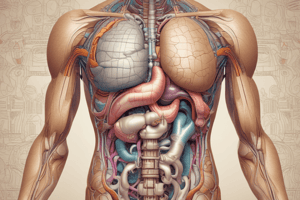Podcast
Questions and Answers
Which layer of the GI tract contains intrinsic nerve plexuses that regulate digestive activity?
Which layer of the GI tract contains intrinsic nerve plexuses that regulate digestive activity?
- Serosa
- Mucosa
- Muscularis externa (correct)
- Submucosa
What is the primary role of the liver in the digestive process?
What is the primary role of the liver in the digestive process?
- Creating pancreatic juice
- Storing bile
- Absorbing nutrients
- Producing bile (correct)
What structure in the small intestine enhances nutrient absorption by increasing surface area?
What structure in the small intestine enhances nutrient absorption by increasing surface area?
- Circular folds
- Villi (correct)
- Microvilli
- Peyer's patches
Which accessory organ of the digestive system produces pancreatic juice?
Which accessory organ of the digestive system produces pancreatic juice?
What is the role of the large intestine in the digestive process?
What is the role of the large intestine in the digestive process?
What are the three main parts of the portal triad in the liver?
What are the three main parts of the portal triad in the liver?
Which component of the large intestine helps to regulate movement of food through the digestive tract?
Which component of the large intestine helps to regulate movement of food through the digestive tract?
What are the six main actions that occur during the digestive process?
What are the six main actions that occur during the digestive process?
What is the role of Peyer's patches in the small intestine?
What is the role of Peyer's patches in the small intestine?
Which accessory organ of the digestive system stores bile and releases it into the small intestine?
Which accessory organ of the digestive system stores bile and releases it into the small intestine?
Study Notes
- The human body requires nutrients from food in addition to oxygen for sustenance, leading to the need for digestion.
- The digestive system consists of the alimentary canal (GI tract) and accessory organs like teeth, tongue, salivary glands, liver, and pancreas.
- The digestive process involves six main actions: ingestion, propulsion, mechanical breakdown, digestion by enzymes, absorption, and defecation.
- The GI tract consists of layers including mucosa, submucosa, muscularis externa, and serosa, with intrinsic nerve plexuses regulating digestive activity.
- Accessory organs like the liver, gallbladder, and pancreas play crucial roles in digestion by producing bile, storing bile, and secreting pancreatic juice with enzymes.
- The small intestine is key for nutrient absorption, with structures like circular folds, villi, microvilli, and Peyer's patches enhancing surface area for absorption.
- The liver's lobules contain hepatocytes and portal triads with bile ducts, arterioles, and venules, while the pancreas produces pancreatic juice through acinar cells.
- The large intestine follows the small intestine and absorbs water, with indigestible remnants being expelled during defecation.- Large intestine absorbs water and compacts food residues into fecal matter before elimination through the anus.
- Components of the large intestine include tenia coli (muscle bands), haustra (sacs), and epiploic appendages (fat-filled pouches).
- The large intestine is divided into cecum, appendix, colon, rectum, and anal canal with specific functions for each section.
- Different segments of the colon are ascending, transverse, descending, and sigmoid colon, each contributing to the digestion process.
- Enzymes are essential for breaking down biomolecules like proteins, carbohydrates, and fats during the digestive process.
Studying That Suits You
Use AI to generate personalized quizzes and flashcards to suit your learning preferences.
Description
Test your knowledge on the anatomy and functions of the digestive system, including the GI tract, accessory organs, nutrient absorption, and enzyme actions. Learn about key structures like villi, hepatocytes, and tenia coli.




